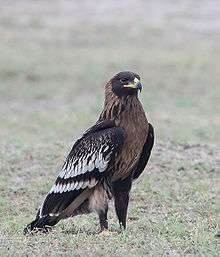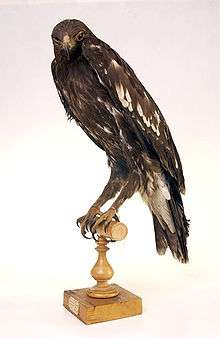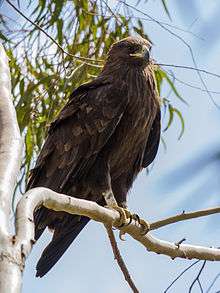Greater spotted eagle
| Greater spotted eagle | |
|---|---|
 | |
| At Tal Chhapar Sanctuary, Rajasthan | |
| Scientific classification | |
| Kingdom: | Animalia |
| Phylum: | Chordata |
| Class: | Aves |
| Subclass: | Neornithes |
| Infraclass: | Neognathae |
| Superorder: | Neoaves |
| Order: | Accipitriformes |
| Family: | Accipitridae |
| Subfamily: | Buteoninae (disputed) |
| Genus: | Clanga |
| Species: | C. clanga |
| Binomial name | |
| Clanga clanga (Pallas, 1811) | |
| | |
| Range of C. clanga Breeding range Wintering range | |
| Synonyms | |
|
Aquila clanga | |
The greater spotted eagle (Clanga clanga), occasionally just called the spotted eagle, is a large bird of prey. Like all typical eagles, it belongs to the family Accipitridae. The scientific name clanga is from Ancient Greek κλαγγή, "scream".[2]
Description

The eagle is 59–71 cm (23–28 in) in length and has a wingspan of 157–179 cm (5.15–5.87 ft). Typical body mass is 1.6–2.5 kg (3.5–5.5 lb), with an occasional big female weighing up to 3.2 kg (7.1 lb).[3][4]
There is often a less obvious white patch on the upperwings, but a light crescent on the primary remiges is a good field mark. The white V mark on the rump is less clear-cut in adults than in the lesser spotted eagle (C. pomarina). The juvenile has white spots all over its wings and lacks a lighter nape patch.
The call is a dog-like yip.
Identification
This medium-sized eagle is very similar in general appearance to its closest relative the lesser spotted eagle, which shares part of its range. Head and wing coverts are very dark brown and contrast with the generally medium brown plumage; the lesser spotted eagle has a paler head and wing coverts. The head is small for an eagle. The similarities of the greater spotted to the lesser spotted often results in misidentification as being that species. This is further complicated by occasional hybrids between the two species.[5]
In winter, it occurs in the range of the Indian spotted eagle (C. hastata). From this recently validated relative, it can be distinguished by the darker color and lighter eye (not darker than the body plumage at distance, lighter at close range), and in juveniles, the strong spotting. It is also a bit larger – though this cannot be reliably estimated in the field – and in the winter quarters prefers wetland habitat.
Systematics, taxonomy and evolution
The typical eagles are often united with the buteos (Buteo), sea eagles (Haliaetus) and other more heavy-set Accipitridae, but they may be less distinct than formerly believed from the more slender accipitrine hawks. The lesser spotted eagle is the greater spotted eagle's closest living relative; their common ancestor seems to have diverged around the middle Pliocene, perhaps some 3.6 million years ago (mya),[note 1] from the ancestors of the Indian spotted eagle that lives across Iran, Pakistan and India. The "proto-spotted eagle" probably lived in the general region of Afghanistan, being split into a northern and a southern lineage when both glaciers and deserts advanced in Central Asia as the last ice age began. The northern lineage subsequently separated into the eastern (greater) and western (lesser) species of today, probably around the Pliocene-Pleistocene boundary not quite 2 mya.[6][7][8]
The spotted eagles are quite distinct as a group from the typical members of Aquila, the "true eagles". They will probably be included with their putative tropical relatives in Lophaetus or Ictinaetus, or moved to a genus of their own in the future.
Distribution and habitat
This is a species of wooded country. The population is entirely migratory. It breeds from northern Europe eastwards across Asia, and winters in south-eastern Europe, north-eastern Africa, the Middle East and southern Asia. Migration to the breeding grounds takes place fairly late; in Bhutan, for example, birds can be seen with some regularity until the end of March.[9]
Movements
This species is prone to vagrancy. Its regular breeding range no longer extends as far westwards as Germany but birds are still occasionally seen there with a few records per decade. Even young birds disperse widely; the Staatliches Museum für Tierkunde Dresden has a specimen (C 21845) shot in November 1914 near Bernsdorf in Saxony. It is a juvenile, and though its exact age cannot be determined it is heavily spotted and probably less than 20 months old.[10]
An adult greater spotted was tagged with a satellite transponder in 1993 in order to track migration. The tagged eagle migrated a total of 5,526 km (3,434 mi) from its wintering grounds in Yemen to it breeding grounds in western Siberia. It moved 150 km (93 mi) on average each day, but this increased to 280 km (170 mi) per day as the bird flew through Mesopotamia.[11]
Behaviour
In its winter range, the species is more social than when breeding. Small flocks of up to ten birds or so, of varying age, can be seen to patrol the land together. They also associate with other Accipitridae such as local and/or migrant black kites (Milvus migrans lineatus and govinda) or steppe eagles (A. nipalensis), distinctly smaller and larger raptors, respectively.[9]
Feeding
The eagle hunts small mammals and similar, mainly terrestrial, prey.
Breeding
This eagle lays 1–3 eggs in a tree nest. Generally territorial, juveniles spend some time with their parents after fledging, until they reach sexual maturity and seek out a territory and a mate of their own.
Status and conservation
It is classified as vulnerable to extinction by the IUCN.[1] As of 2000, the world population of this eagle was estimated at less than 4,000 breeding pairs. The primary threats are habit degradation and habitat loss, as well as human disturbance during the mating season.[12]
Gallery
 Wintering in Israel
Wintering in Israel
 Upperside of adult wintering in Bharatpur (Rajasthan, India)
Upperside of adult wintering in Bharatpur (Rajasthan, India)
Note light wing stripes Greater spotted eagle in flight, wintering in Israel
Greater spotted eagle in flight, wintering in Israel
Notes
- ↑ The estimate in Väli 2006 is certainly incorrect; it uses a molecular clock that is appropriate for small passerines with half the generation times of eagles.
References
- 1 2 BirdLife International (2013). "Clanga clanga". IUCN Red List of Threatened Species. Version 2013.2. International Union for Conservation of Nature. Retrieved 26 November 2013.
- ↑ Jobling, James A (2010). The Helm Dictionary of Scientific Bird Names. London: Christopher Helm. p. 110. ISBN 978-1-4081-2501-4.
- ↑ Ferguson-Lees, J.; Christie, D. (2001). Raptors of the World. Houghton Mifflin Harcourt. ISBN 0-618-12762-3.
- ↑ Dunning, John B. Jr., ed. (1992). CRC Handbook of Avian Body Masses. CRC Press. ISBN 978-0-8493-4258-5.
- ↑ Väli, Ülo; Lõhmus, Asko (2004). "Nestling characteristics and identification of the lesser spotted eagle Aquila pomarina, greater spotted eagle A. clanga, and their hybrids". Journal of Ornithology. 145 (3): 256–263. doi:10.1007/s10336-004-0028-7.
- ↑ Parry, S.J.; Clark, W.S.; Prakash, V. (2002). "On the taxonomic status of the Indian Spotted Eagle Aquila hastata". Ibis. 144 (4): 665–675. doi:10.1046/j.1474-919X.2002.00109.x.
- ↑ Rasmussen, Pamela C.; Anderton, John C. (2005). Birds of South Asia - The Ripley Guide. Barcelona: Lynx Edicions. ISBN 84-87334-67-9.
- ↑ Väli, Ülo (2006). "Mitochondrial DNA sequences support species status for the Indian Spotted Eagle Aquila hastata" (PDF). Bulletin of the British Ornithologists' Club. 126 (3): 238–242.
- 1 2 Bishop, K. David (1999). "Preliminary notes on some birds in Bhutan" (PDF). Forktail. 15: 87–91.
- ↑ Töpfer, Till (2007). "Nachweise seltener Vogeltaxa (Aves) in Sachsen aus der ornithologischen Sammlung des Museums für Tierkunde Dresden" [Records of rare bird taxa (Aves) in Saxony from the ornithological collection of the Zoological Museum Dresden]. Faunistische Abhandlungen (in German and English). 26 (3): 63–101.
- ↑ Meyburg, Bernd-U.; Eichaker, Xavier; Meyburg, Christiane; Paillat, Patrick (1995). "Migrations of an adult Spotted Eagle tracked by satellite" (PDF). British Birds. 88: 357–361.
- ↑ Väli, Ülo; Lõhmus, Asko (2000). "Suur-konnakotkas ja tema kaitse Eestis" [The Greater Spotted Eagle and its conservation in Estonia]. Hirundo. Supplement 3: 1–50.
Further reading
- Svensson, Lars (1–8 November 1986). Underwing pattern of Steppe, Spotted and Lesser Spotted Eagles. International Bird Identification: Proceeedings of the 4th International Identification Meeting. Eilat: International Birdwatching Centre Eilat. pp. 12–14.
External links
| Wikimedia Commons has media related to Clanga clanga. |
| Wikispecies has information related to: Clanga clanga |
- Greater spotted eagle Photographs, text and map at Oiseaux.net
- BirdLife species factsheet for Clanga clanga
- "Clanga clanga". Avibase.
- "Greater spotted eagle media". Internet Bird Collection.
- Greater spotted eagle photo gallery at VIREO (Drexel University)
- Audio recordings of Greater spotted eagle on Xeno-canto.
